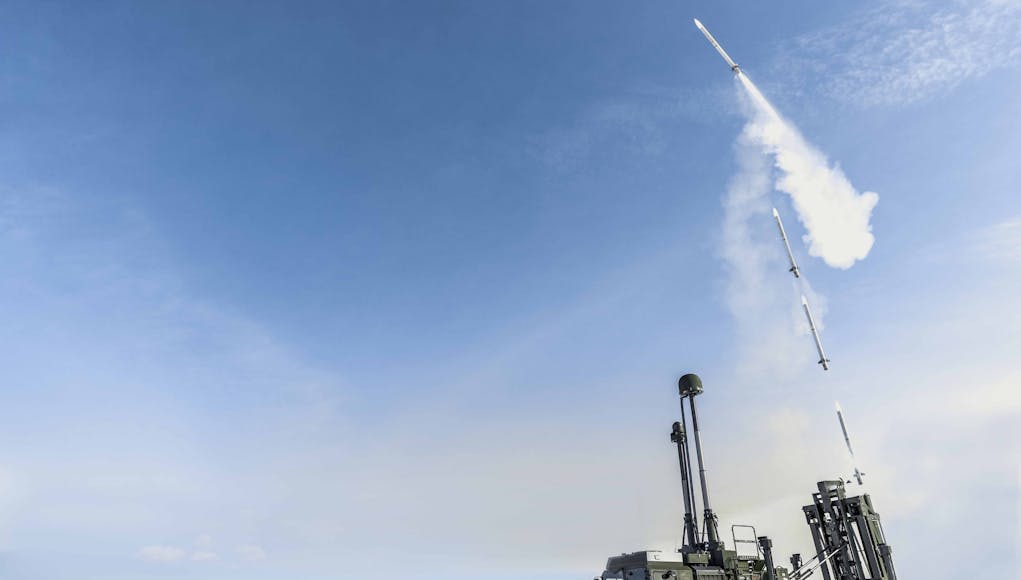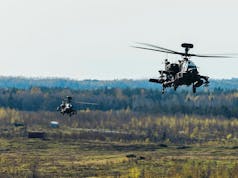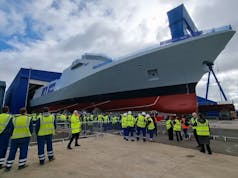The Land Ceptor air defence system has successfully destroyed its target during an end-to-end system demonstration firing at the Vidsel Test Range in Sweden, an important milestone for the project prior to entry to service with the British Army.
Land Ceptor utilises the Common Anti-air Modular Missile currently in production and delivering a common stockpile to meet the air defence needs of both the British Army and the Royal Navy (as Sea Ceptor). In British Army service Land Ceptor will replace the current Rapier air defence system and provides a step-change in capability, including over triple the range and the ability to intercept a much more challenging target set.
This included testing of the launcher; munition loading; receipt of air tracks from a Giraffe-AMB radar; air track processing by Land Ceptor’s onboard command and control (C2) system; and execution of a full engagement chain, with two-way data exchange with the missile during its mid-course fly-out phase, and successful interception and destruction of a target using the missile’s seeker in the terminal phase.
MBDA say about the system:
“Land Ceptor with CAMM is the latest generation of air defence system, providing exceptional capability from very short ranges (VSHORAD) below 1 km into the medium range air defence (MRAD) tier beyond 25km. Key features of CAMM are its next generation solid-state active radar seeker, two way data-link, low-signature rocket motor and its 360° soft-vertical launch system.
These combine to enable the missile to rapidly intercept the most challenging and dangerous of threats including saturation attacks from precision guided munitions and manoeuvring high-speed missiles emerging late from low altitude and from multiple directions simultaneously.”
The demonstration in Vidsel coincides with the transition into production of the Land Ceptor weapon system, which will now undergo system-of-system integration and test as part of the British Army’s Sky Sabre air defence architecture.














Here’s the video:
https://www.youtube.com/watch?v=bAGm5aOzJEQ
Thanks. I loved seeing the soft/cold launch in action. It’s pretty cool (no pun intended!) how the tail thrusters orient it in the direction it wants to go before it fires its main engine so, apart from a bit of thruster gas, no real exhaust efflux goes down towards the launch site.
What is the target drone? Am I correct in assuming that it is subsonic? I know this is billed as just one in a series of test firings but I hope at some point we’ll see it successfully intercept supersonic targets as well (assuming this one isn’t already).
Julian wrote:
“What is the target drone?”
It looks like one of the the QinetiQ Banshee target drones, I’d say the Twin-Jet Banshee with a rocket assist
http://targetsystems.qinetiq.com/en-ca/products-and-services/fixed-wing-aerial-targets/twin-jet-banshee/
Banshee is a delta winged target drone, from the video it doesn’t look delta winged.
Mike wrote:
It does doesn’t it. I missed the pod underneath due to it being painted red.
[…] post Land Ceptor tested against target drone in Baltics appeared first on UK Defence […]
Not definitely sure, but I think it’s a BQM167 target drone.
Which is small modern subsonic drone used to replicate 4th generation aircraft.
How does a subsonic drone replicate a 4th generation aircraft, which for sure would be supersonic?
Replicate the high agility of a 4th generation aircraft rather than the speed.
To intercept a supersonic target is a question of mathematics, to intercept a highly agile target is more difficult.
I would assume even more difficult to intercept a highly agile supersonic target.
Supersonic aircraft lose agility due to the increased G force exerted on the airframe.
I wonder how much this explains how badly the various air defence missiles have performed over the years. A real plane will utilise a combination of speed and agility to avoid a missile.
Its a MQM-107
Its a MQM-107
I mean triple the range for a system that was already agonisingly short ranged isn’t much but we’ll take it. We still despratly need a long range ground to air missile.
Why?
You don’t just get the long range missile, its all the other systems that go with it.
Long range air search, IFF, C3, data links, hugh logistics foot print.
CAMM is quite mobile so its resistance to counter battery fire is good…it can shoot, pack up and scoot.
The same cannot be said for say Patriot which is a large system, not mobile and sits fat dumb and happy on the ground for all to see and target.
it depends what the role is and what it is defending. If tasked with defending the main land, it would need to cover ports and cities etc, which would stretch this systems range to breaking point (how many would be required to cover say London).
Then there is the topic of stand off weapons, being able to take out the source and not just the weapon is a huge advantage.
Also being able to position far enough away from the front line to avoid incoming missiles / artillery.
Realistically the main land is not under threat, so probably this place the typhoons are sufficient for the job.
The capability and money is being put into detecting and neutralising the launch vehicle before it can do any damage. Hence T26’s, Typhoons, Astutes, F35’s and Carriers. Granted we could use more of the first 4 but you get the point.
Gunbuster – how air portable is this system? Can it be transported by chinook or Merlin, for example?
I assume it is air transportable by Hercules, Altas or C17.
You will not be able to get the vehicle/launcher into a Hercules.
Doubt it will be able to be airlifted by a chinook as an external load.
Thanks Mike…. so its wheels only for tactical movement, and relying on A400Ms and C17s for strategic mobility?
C17 no problem, for rapid deployment the British army will be reliant on manportable starstreak for air defence.
Not perfect solution given its limitations, but better than nothing.
How much of a service life has either portable or stormer-mounted Starstreak got left? It seems to be a capability that is being cut to the bone.
In fact, we seem to have very little SHORAD capability, which Land Ceptor will hopefully at least partially address, but I’m not aware of a replacement for StarStreak any time soon. Is there one?
Not by Chinook or C-130. Certainly by A400M and C-17. Seldom have I seen a new weapon system that makes so much sense, and represents such good value for money. Well done MBDA and well done MOD/DE&S!
Air defence systems need missiles that extremely fast and agile, a suite of sensors, long range, quick reaction times, extensive electronic warfare capability, mobility and the ability to engage several different targets at the same time whether they be ballistic missiles or low flying aircraft.
Not much to ask for.
With 20 minutes (i assume best case is being quoted and realistic will be longer) needed to deploy, its range would be a extreme limiting factor if supporting the strike brigade, which is designed to move fast, and so could easily out range the unit rapidly.
It would be better to have a longer range unit, that sits back and covers the advance from a distance and then could play leapfrog with a 2nd unit.
I wonder how stabilised these units need to be and whether it would be theoretically possible to park them on the QE or Albions or even support ships to provide air defence in a worst case situation.
99/100 realistic scenario of wars, our ships will be reinforced by ally ships and so the serious lack of depth would be overcome, but in that worst case where we go it alone, putting something in place is better than nothing and soft launch would appear to Indicate it could be possible.
All in a word “drones”, slow speed disposable stealth-cloaked commodity items for bad actors. GPS denial wont do anything as drone technology uses other methods of navigation and target acquisition.
Land ceptor and sea ceptor are going to be massive export successes. They provide just what many NATO and allied countries need right now. Watch the export orders roll in.
Good news for ukplc and well done to our government and armed forces for pushing this system into production.
Now we just need to utilise it to the maximum and order enough land ceptor a to provide air defence umbrella the army needs to operate and protect some key sites.
I would think 10 batteries (30 launchers) would be a decent initial capability.